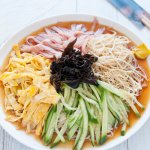
Hiyashi chūka is made with cold Chinese-style egg noodles, with sweet vinegar sauce topped with vegetables, egg and meat. It is a great dish to have on a hot summer day. The instructions are long because I have explained the preparation of toppings in detail. But it is actually quite fast to make and minimal cooking is required. You can vary the toppings if you like. Please see note 5 for suggested toppings.
- 100 g (3.5oz) cucumber
- 100 g (3.5oz) bean sprouts
- 100 g (3.5oz) sliced ham (note 1)
- 5 g (0.2oz) dried black fungus (wood ear fungus/mushroom) rehydrated
- 160 - 200 g (5.6 - 8oz) fresh egg noodles (note 2)
- 2 eggs beaten
- a pinch of salt
- a pinch of sugar
- ½ tbsp oil
- 4 tbsp soy sauce
- 3 tbsp rice vinegar
- 2 tbsp dashi stock (note 3)
- 2 tbsp sugar
- 1 tbsp sake
- ½ tbsp sesame oil
- Hot mustard (optional)
-
Add rice vinegar, dashi stock and sugar to a small pot and place it over high heat to warm it up enough to dissolve the sugar. You can do this in the microwave, if you prefer.
-
Remove from the heat. Add the remaining Sauce ingredients and mix. Leave until required.
-
Slice cucumber diagonally into 3mm (⅛") thick, 7cm long slices. Then julienne them into 3mm (⅛") wide sticks.
-
Steam or boil bean sprouts for a few minutes, then cool them down. If using a microwave, place bean sprouts in a bowl, covered with cling wrap, then cook for 2 minutes on high.
-
Slice the ham into 5mm (3/16") strips.
-
Boil black fungus for a minute, drain and finely slice it.
-
Mix the Kinshi Tamago ingredients in a bowl.
-
Add oil to a non-stick frypan and heat over medium high heat. Wipe excess oil with kitchen paper.
-
Hold the handle of the frypan in your dominant hand. Pour the egg mixture into the centre of the frypan with the other hand while moving the frypan to spread the egg outward thinly. You should use about 1/3 of the egg mixture using a frypan with a 25cm (10") diameter.
-
Cook for about 1 minute until the surface of the egg is almost cooked.
-
Using a cooking chopstick or a cake spatula, lift the egg gently and turn it over.
-
Cook for another 15-30 seconds. Place the frypan upside down onto a large cutting board to remove the egg crepe onto the board.
-
Repeat with the rest of egg mixture and place cooked crepes on top of each other.
-
Cut the crepes into half to semi-circle shape. Place one pile of semi-circle on top of the other and cut the crepes into 5mm (3/16") wide slices perpendicular to the first cut.
-
Boil water in a large pot and add noodles. Try to untangle strands of noodles when adding to the boiling water.
-
Immediately after putting the noodles into the boiling water, use chopsticks or a fork to pick and drop some strands ensuring that each strand is separated.
-
Cook for a few minutes as per the instructions on the noodle package.
-
Using a sieve, drain and rinse under cold water until the noodles are completely cooled down.
-
Shake excess water from the noodles off as much as possible and place them onto two serving plates.
-
Group each topping together, and place them on the noodles so that sliced toppings are all pointing to the centre except the black fungus which is placed in the centre .
-
Pour the sauce over and place the mustard on the side of the plate if using.
1. I used smoked leg ham but you can use any kind of ham. Other typical meat toppings are steamed chicken and yakibuta. I am planning to post yakibuta recipe next week.
2. I used thin Chinese egg noodles as I had some in the fridge. But you can use slightly thicker ones or even dried noodles (please see the sample photos in the blog). I find that ready-to-use steamed noodles tend to be too soft without firmness.
Hokkein noodles and Chow Mein noodles are not suitable.
3. Please refer to Home Style Japanese Dashi Stock to make dashi stock. If you prefer stronger flavour, you could reduce the amount of dashi stock or even omit.
4. You could also sprinkle roasted white sesame seeds or finely julienned yakinori (roasted seaweed) over the toppings. Some shops also add pickled red ginger in the centre to add colour to the dish.
5. Topping can vary. Other suggested toppings include sliced tomatoes, rehydrated wakame seaweed, blanched julienned carrot, steamed/blanched chicken breast, crab meat, prawns, julienned yakibuta (Japanee char siu - recipe will come soon).